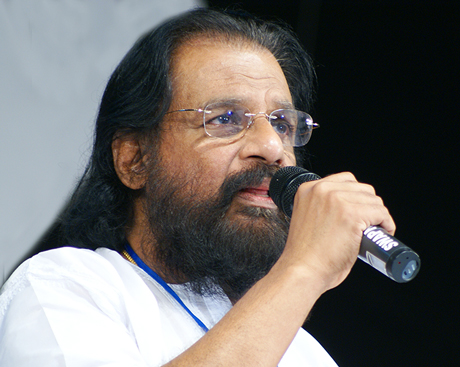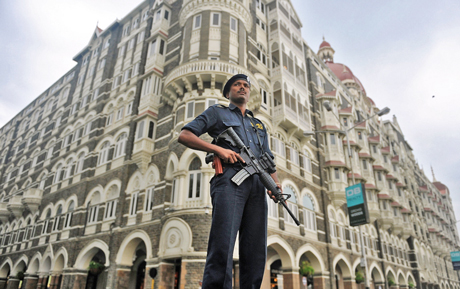Bollywood Masala Mix
with a Divine voice

Kattassery Joseph Yesudas or Jesudas is a classical musician and a leading playback singer.
His voice lends itself well to both Indian classical, devotional and popular songs. He has recorded more than 40,000 songs in many languages, including Tamil, Hindi, Malayalam, Kannada, Telugu, Bengali, Gujarati, Oriya, Marathi, Punjabi, Sanskrit, Tulu, Russian, Arabic, Latin and English through his long career.
He has been singing for most Indian languages, except Assamese and Kashmiri. In his heyday, he was known as the Jim Reeves of South India. Fans term his voice as nothing short of "divine".
K. J. Yesudas was born in Fort Kochi, Kerala, to Augustine Joseph and Elizabeth. His father, who was a well-known Malayalam classical musician and stage actor, was his first guru. Later, he joined the Music Academy in Thrippunithura and underwent training.
For a brief period, he was with Sri Vechur Hari Hara Subramania Iyer, after which he took training from Chembai Vaidyanatha Bhagavatar, a maestro of classical music. Although he is a Carnatic music expert, he mastered in Hindustani music as well.
Yesudas began his career in playback singing in Kollywood in the early 60's; and by mid 70's, he entered Bollywood. He has bagged seven National Film Awards for the best singer category in the Indian film industry. In 2006, he sang 16 film songs in four South Indian languages on the same day at AVM Studio, Chennai.
Yesudas has performed in many major cities around the world. In his music concerts in the Middle East, he sings Arabic songs in the Carnatic style. He frequently dons the role of a cultural ambassador of India through his innumerable performances abroad by promoting Indian music.
He is the only singer who has been accorded the title Asthana Gayakan (official singer) of Kerala state. He has been awarded the Padma Sri (1973) and Padma Bhushan (2002).
In 1965, he was invited by the Soviet Union government to perform at music concerts in various cities in the USSR and also sang a Russian song over Radio Kazakhstan. In 1970, he was nominated to head the Sangeetha Nataka Academy of Kerala and was the youngest person ever to occupy that post.
In 1971, Yesudas with his musical troupe travelled all over Kerala to raise funds for the Indian Prime Minister's National Defense Fund during the Indo-Pakistan War. He also became the senate member in the International Parliament for Safety and Peace.
He has taken the words of Sree Narayana Guru, "One Religion, One Caste for all humans" to heart. On November 14, 1999, Yesudas was presented with an honorary award by the UNESCO for "Outstanding Achievements in Music and Peace" at the "Music for Peace" event in Paris, a concert held to mark the dawn of the new millennium and whose attendees included artistes such as Lionel Richie, Ray Charles, Montserrat Caballé, and Zubin Mehta.
His unparalleled record of winning state awards for best singer in five regional languages of India and winning National awards for best singer seven times in three languages places him among the most versatile singers India has ever seen.
Shree Narayana Guru’s great message, "One caste, One religion and One God for all Humans", influenced young Yesudas in his dealings with his fellow men. He had his own heroes among the musicians too. Mohammed Rafi, Chembai Vaidyanatha Bhagavatar and Balamurali Krishna are the ones he admired the most.
He completed the Ganabooshanam course at R.L.V. Music Academy, Thripunithura, Cochin. And he graduated from the Sree Swathithirunal Music Academy, Trivandrum. Trained under well-known musicians like K.R. Kumaraswamy (former principal of the Music College, Kochi), Kunjuvelan Aasan (a disciple of Nagaswera Vidwan Rajaratnam Pillai), Augustine Joseph, Ramakutti Bagavathar, Sivaraman Nayar, Semmangudi Srinivasa Iyer and Chembai Vaidyanatha Bhagavatar, Yesudas was the audience's favourite from day 1.
Yesudas is married to Prabha for more than 30 years. They have three sons, Vinod, Vijay and Vishal. The second son Vijay Yesudas, is a budding musician. The family is currently settled in Chennai and Kerala. He also owns estates in Fort Lauderdale, Florida, USA, and Flower Mound, TX, USA, for personal and business reasons.
In 1980, Yesudas established the Tharangni Studio at Trivandrum. In 1992, the office and studio were moved to Chennai and the company was incorporated in the US in 1998. Tharangni Studio and Tharangni Records became a recording center in Kerala which, for the first time, brought out audio cassettes of Malayalam film songs in stereo. The record company also had a voice mixing studio in Chennai, Studio27. The studio continues to produce and present events of Yesudas, both for film and Indian classical music concerts throughout the world.

The 2008 attacks, widely attributed to members of the Pakistan-based terrorist organization Lashkar-e-Taiba, are newly relevant because of last week’s coordinated suicide bombings across Sri Lanka, which killed more than 300 people. Perhaps inspired by Mumbai’s model, the targets in Sri Lanka included luxury hotels in Colombo, likely because that is where the perpetrators would be able to kill wealthy tourists – and how they would capture global media attention.
India’s 2008 experience is also back in the public consciousness because of the new film Hotel Mumbai. Starring the well-known international actors Dev Patel, Armie Hammer, Nazanin Boniadi, Jason Isaacs, and Anupam Kher, the movie provides a compelling account of the coordinated assault that gripped the country’s financial capital for nearly 72 hours. And while the attacks spanned several locations – including a heavily trafficked railway terminal, a Jewish outreach center, and a posh hotel called the Oberoi – the movie recounts three days and nights of horror mostly from within one hotel, the glamorous Taj.
As with any film, Hotel Mumbai takes cinematic liberties by changing the sequence of a few events and adding fictional scenes for dramatic effect. However, for the most part, the film deftly captures the fear that this unprecedented attack unleashed on a hapless city’s inhabitants and visitors.
Patel, a British actor of Indian origin cast in the role of a hotel employee, provides an accurate yet painful glimpse of the profound inequality that defines modern India. After waking up in a squalid slum, quickly grooming himself, and dropping off his child at an improvised day care, he wends his way to the gleaming Taj hotel barely in time for his shift. Throughout the film his character showcases how those on the lower rungs of the hospitality industry are expected to be suitably obsequious as they attend to the whims of the country’s wealthy and powerful.
Most importantly, Hotel Mumbai deserves credit for depicting India’s shambolic security response. Mumbai’s police are shown to be hopelessly ill-equipped and outgunned. Were it not for the courage of these police officers and the selfless acts of the Taj’s hotel staff, the overall death toll for the attacks could have stretched well beyond the official count of 174. The mettle of the hotel staff is embodied by the performance of Kher, a veteran Indian actor who plays the role of the real-life head chef of the hotel, Hemant Oberoi. As the terrorists open fire across the Taj, Oberoi saves several lives by calmly moving guests into an exclusive section of the hotel, the Chambers. The question, however, is why heroes like Oberoi were needed in the first place. What steps has India taken to secure its cities from a reoccurrence?
It is now well known that Indian intelligence agencies had received warnings from their U.S. counterparts about an impending attack. However, there were no specific alerts. When the attacks began, local and national security authorities were caught flat-footed. It turned out India had no dedicated counterterrorism force. And the country’s elite National Security Guard (NSG) commandos were in a base just outside New Delhi, with no local presence in or around Mumbai. When the commandos were informed about the attack, they lacked a dedicated aircraft to fly to Mumbai. As a result, they arrived at the scene nine hours after the attack began, by which time the terrorists had not only killed dozens of people but had also taken hostages at the Taj hotel, prolonging the attack for a further two days.
Other structural and idiosyncratic factors worsened the response to the crisis. Routine policework is controlled by individual states in India. As a result, federal police or paramilitary forces can, under most circumstances, only be deployed when a state government explicitly seeks their services. Accordingly, the state government of Maharashtra, of which Mumbai is the capital, had to specifically ask the central government to send in NSG forces to cope with the onslaught. This established procedure, in turn, wasted critical hours.
Flawed choices worsened the crisis. Shivraj Patil, who as minister of home affairs was at the time the nation’s top law enforcement official, announced on national television the deployment of NSG units to Mumbai. The terrorist handlers in Pakistan, who were in real-time contact with their charges, promptly alerted them to the imminent departure of the commandos for Mumbai. Any hint of surprise that the commandos may have enjoyed was effectively squandered. As Hotel Mumbai depicts, the terrorists began to seize hostages in response to the deployment of NSG forces.
Has India done enough to ensure that similar attacks don’t occur again? After 2008, there was a flurry of proposals to secure urban areas and enhance maritime security. Only a few of those plans have been realized. Today there are NSG hubs in some large Indian cities. India has created a National Investigation Agency to tackle terrorist violence. The Mumbai police has a dedicated counterterrorism unit within its ranks. Some efforts have been made to secure India’s vast coastline. But there are still several well-known systemic flaws that can be exploited. In the event of a crisis, individual states still need to formally request federal help, which could slow down response times. The security of ports remains patchy: Coastal police still lack adequate equipment and, in 2016, an Indian Intelligence Bureau audit concluded that 187 out of 227 minor ports still lacked any meaningful security measure. Some national security precautions, while implemented, are not taken seriously: At Mumbai’s Chhatrapati Shivaji Railway Terminus, the site of a major massacre during the 2008 terrorist attacks, metal detectors routinely go off as local police pay scant heed. And at hotels across the country, guards make a show of scanning guests, but it is well known that the checks are easy to sidestep. India’s security personnel remain outgunned: While a series of checkpoints have been set up across cities such as Mumbai, the police manning them are armed with World War II-era rifles.
Other institutional reforms announced in the aftermath of the 2008 attacks remain in abeyance. For example, plans were made for the creation of an apex National Counter Terrorism Centre, modeled along the lines of the United States’ organization of the same name. However, owing to both political and bureaucratic constraints, this entity has yet to be set up. Similarly, a national grid for the sharing of intelligence across various agencies remains in limbo, as intelligence organizations are still unwilling to share information with one another. Other critical gaps also remain. For example, most railway stations still do not have bomb detection and disposal squads. India is especially vulnerable along its coastline: While fishing boats of 20 feet or longer are required to have automated identification systems, smaller boats face no such requirements. Fishermen are required to have biometric identification but there are no checks on whether they have them or not. All of this is especially galling because the Mumbai attackers came ashore at a small fishing village near the city, and on a small boat.